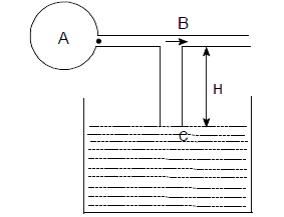The below picture is of a aspirator pump. If we press the bulb at A the air in it with density $\sigma$ will flow out with velocity $V$. This would cause lower pressure at B and hence the liquid with density $\rho $ will come up. The Gauge pressure is $P$.
I don't understand how this works. The term 'Gauge Pressure' confuses me. It isn't the pressure at A nor it is the pressure at B, so what is it?
Now I apply Bernoulli's principle for the air. So the pressure at A equals the pressure at B + $\frac 12 \sigma V^2$, right? But below the text I find this equation.$$ P_B + \frac 12 \sigma V^2 = P_A + P$$ How does gauge pressure enter this equation?
Now I try to find the excess pressure at B. So it should be $ P_B + \rho gH = P_C $ (excess pressure at a depth). But I find this equation. $$ P_B=P_A - \rho gH $$ Where does $ P_A $ come from?

